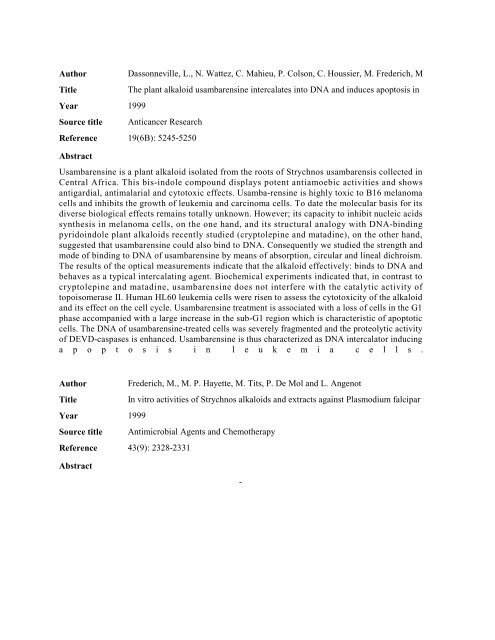Strychnos 1990 - 2004 - Crops for the Future
Strychnos 1990 - 2004 - Crops for the Future
Strychnos 1990 - 2004 - Crops for the Future
Create successful ePaper yourself
Turn your PDF publications into a flip-book with our unique Google optimized e-Paper software.
Author<br />
Title<br />
Year<br />
Source title<br />
Reference<br />
Dassonneville, L., N. Wattez, C. Mahieu, P. Colson, C. Houssier, M. Frederich, M<br />
The plant alkaloid usambarensine intercalates into DNA and induces apoptosis in<br />
1999<br />
Anticancer Research<br />
19(6B): 5245-5250<br />
Abstract<br />
Usambarensine is a plant alkaloid isolated from <strong>the</strong> roots of <strong>Strychnos</strong> usambarensis collected in<br />
Central Africa. This bis-indole compound displays potent antiamoebic activities and shows<br />
antigardial, antimalarial and cytotoxic effects. Usamba-rensine is highly toxic to B16 melanoma<br />
cells and inhibits <strong>the</strong> growth of leukemia and carcinoma cells. To date <strong>the</strong> molecular basis <strong>for</strong> its<br />
diverse biological effects remains totally unknown. However; its capacity to inhibit nucleic acids<br />
syn<strong>the</strong>sis in melanoma cells, on <strong>the</strong> one hand, and its structural analogy with DNA-binding<br />
pyridoindole plant alkaloids recently studied (cryptolepine and matadine), on <strong>the</strong> o<strong>the</strong>r hand,<br />
suggested that usambarensine could also bind to DNA. Consequently we studied <strong>the</strong> strength and<br />
mode of binding to DNA of usambarensine by means of absorption, circular and lineal dichroism.<br />
The results of <strong>the</strong> optical measurements indicate that <strong>the</strong> alkaloid effectively: binds to DNA and<br />
behaves as a typical intercalating agent. Biochemical experiments indicated that, in contrast to<br />
cryptolepine and matadine, usambarensine does not interfere with <strong>the</strong> catalytic activity of<br />
topoisomerase II. Human HL60 leukemia cells were risen to assess <strong>the</strong> cytotoxicity of <strong>the</strong> alkaloid<br />
and its effect on <strong>the</strong> cell cycle. Usambarensine treatment is associated with a loss of cells in <strong>the</strong> G1<br />
phase accompanied with a large increase in <strong>the</strong> sub-G1 region which is characteristic of apoptotic<br />
cells. The DNA of usambarensine-treated cells was severely fragmented and <strong>the</strong> proteolytic activity<br />
of DEVD-caspases is enhanced. Usambarensine is thus characterized as DNA intercalator inducing<br />
a p o p t o s i s i n l e u k e m i a c e l l s .<br />
Author<br />
Title<br />
Year<br />
Source title<br />
Reference<br />
Abstract<br />
Frederich, M., M. P. Hayette, M. Tits, P. De Mol and L. Angenot<br />
In vitro activities of <strong>Strychnos</strong> alkaloids and extracts against Plasmodium falcipar<br />
1999<br />
Antimicrobial Agents and Chemo<strong>the</strong>rapy<br />
43(9): 2328-2331<br />
-
















